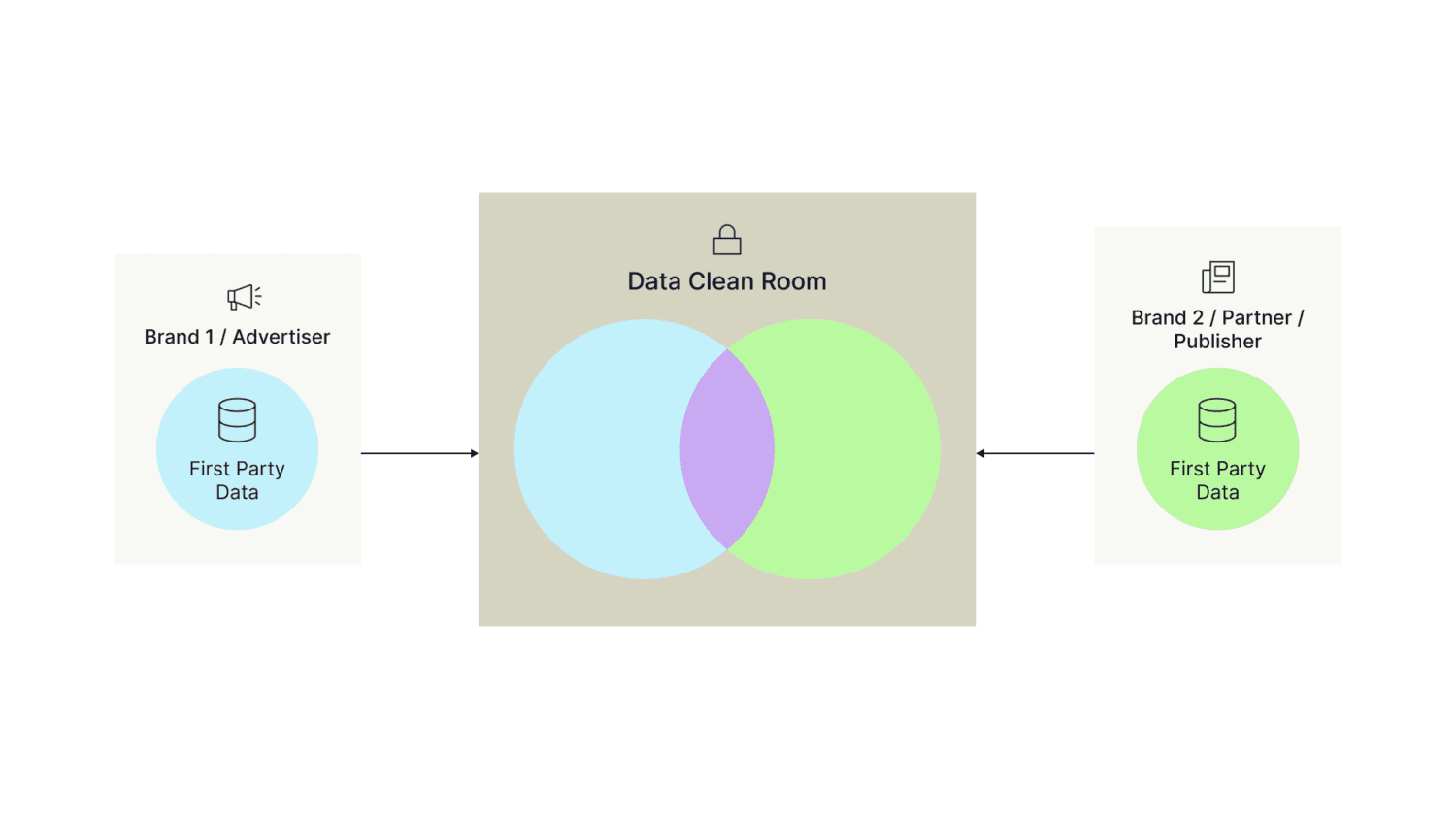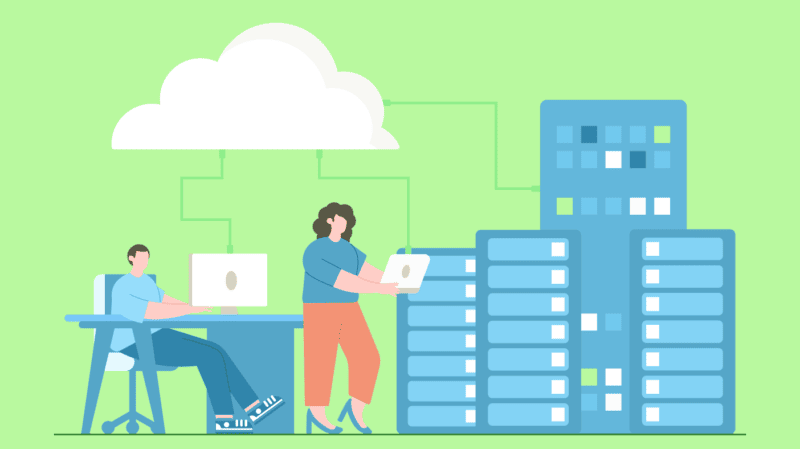The Data Clean Room: What It is and What Advertisers Need to Know

If you’ve been paying attention to the unfolding of data privacy regulations and technology changes, you’ve heard the term “data clean room” (DCR) at least once. And how can you tell that a new technology category is getting momentum and attention? When it earns an acronym of course! Welcome to the DCR.
Explaining the Hype Around Data Clean Rooms
You’ve Heard the Music: Third-Party Cookies Are Going Away
Let’s take a quick step back to better understand how we arrived here.
The last few years have seen a rise in customer data privacy concerns. This led to a cascade of events:
- Europe adopting its first privacy regulation law under the name GDPR (2016)
- Apple limiting and then removing access to third-party cookies from its Safari browser (2017, 2018)
- California adopting and revising its own regulation (CCPA 2018, CPRA 2020)
- Etc.
We could keep going, but the event that really created the highest reaction on the market is Google’s announcement in 2020 to also remove access to third-party cookies from Chrome. Third-party cookies are (only a little longer) the main currency exchange in the advertising industry. Despite its flaws, this is cheap and provides scale.
So what should advertisers, agencies, publishers and tech vendors do?
Join the (Second) Party (Data)
The industry agrees: the best alternative for brands is to focus on their first-party data strategy. Provide value to the consumer in exchange for their (consented) data.
Some industries — such as retailers (thanks to customer transactions) and premium media (thanks to their early subscription and paywall strategy) — are leading the pack in getting access to first-party data. But this is not the case for everybody: most CPG and automotive brands don’t have the same customer data maturity or opportunity.
Across the board, first-party data won’t provide the same scale known with third-party data. So what is the next best alternative? Second-party data.
Second-party data is the first-party data collected by another brand. It can be extremely powerful as it’s someone else’s first-party data! However, as we saw, there are privacy challenges and brands would not give away their most valuable assets so easily.
Now, let’s see how brands can safely access second-party data.
The Inception of Data Clean Room Technology
In 2017, Google led another major industry change: it “quietly” launched a new product called Ads Data Hub. At the time, this beta product was presented as a “next generation insights and reporting” tool.
It was the inception of data clean room technology, but the term was not coined yet. Google announced that it would stop sharing log-level data with advertisers. At least the IDs identifying an individual would no longer be provided.
The challenge? Without access to this data, advertisers would not be able run advanced analytics and reporting on their advertising campaigns on Google properties such as YouTube.
The solution? Ads Data Hub would provide access to the raw data for insights and reporting — without allowing advertisers to export this information in their own tools. Walled Gardens were born, and they don’t give away the valuable collected data anymore, in the name of privacy.
What is a Data Clean Room?
So what is a data clean room (DCR)? In a nutshell, it’s a potluck — but not the traditional one you are familiar with.
First of all, to access the room in which you will taste other people’s food, you need to show your credentials. The entrance is safely guarded 24/7. Then, the room itself is dark so you can’t actually see anybody’s food. And you can’t leave the room with the food either: it’s meant to be tasted “on-site.”
A data clean room is a secure space for data collaboration.
Let’s go deeper on data clean rooms:
- Secure: The environment hosting data is sealed, weatherproof, and privacy-compliant. It means that data stored is encrypted and only authorized users can access it. Data stored in a clean room should not be able to leave that clean room.
- Data Collaboration: The main reason for this environment to exist is to enable data collaboration between two or more parties.
A DCR does not host personal identifiable information (PII) and will not allow for the identification of an individual consumer.
Is a Customer Data Platform a Data Clean Room Too?
While a couple of customer data platform (CDP) vendors announced clean room technology or capabilities in 2021, the purpose and technical capabilities required are different for a CDP and a DCR.
You will find some capability overlap but essentially, a CDP will primarily focus on collecting, organizing and activating first-party data sets. On the other hand, a DCR will enable collaboration between two parties on each other’s first-party data.
You will quickly find that organizations can benefit from both a CDP and a DCR in their stack. These technologies complement each other!
| Customer Data Platform | Data Clean Room | |
|---|---|---|
| OVERVIEW | ||
| Purpose | Enables business teams to take action on customer data via the delivery of personalized customer experiences. | Enables data collaboration between two or more parties. |
| Primary Users | IT, Analytics, Advertising, Marketing, Marketing Ops | Analytics, Advertising, Marketing |
| Data Type | • Any customer data, PII and non-PII • Mostly 1st-party data | • Anonymized data (non-PII) • Mostly 1st- and 2nd-party data |
| Environment “Owner” | Brand (CDP contract owner) | Data owner |
| USE CASES | ||
| Description | Customer experiences planning and activation across the entire customer lifecycle | Data collaboration for insights, ad campaign planning and measurement |
| Examples | • Prospecting • Retargeting • Paid Media Suppression • Welcome Journey • Loyalty • Churn Prediction and Prevention | • Insights • Audience Expansion • Ad Targeting • Ad Measurement • User Attribution |
| Data Access via Environment | Brand data owner only | Brand data owner and approved partners |
| CAPABILITIES | ||
| Digital Data Collection | ✅ | ❌ |
| Data Management | ✅ | ❌ |
| Data Complexity | Supports complex data models | Supports first-party data profiles (ids and attributes), log-level and SKU-level data |
| Data Enrichment | ✅ | ✅ |
| Identity Resolution | ✅ (advanced) | ✅ (simple) |
| Data Matching (for collaboration) | ❌ | ✅ |
| Audiencing | ✅ (advanced) | ✅ (simple) |
| Look-alikes | ✅ (in most CDPs) | ✅ (in most DCRs) |
| Data Access Controls | ✅ (for brand only, simple) | ✅ (advanced) |
| Direct Integration with Paid Media Channels | ✅ | ✅ |
| Activation | Advertising, Marketing, Sales, Services | Advertising, occasionally Marketing |
| Attribution & Measurement | ❌ | ✅ |
Safe and Effective Data Collaboration
Not long after Google, Meta (Facebook at the time) deployed its own clean room technology. These first clean rooms were really built for the biggest advertisers on Google and Facebook properties, the cost made them out of reach for smaller brands.
The data collaboration process itself was run by data engineers and analysts using SQL queries. No marketer would be able to access an interface and discover the insights themselves at the time.
Amazon was even quieter. They were suspected of developing a similar technology, but no public documentation or information was available.
The initial use cases for data clean rooms were focused on improving attribution and measurement for ad buyers. As we saw with Google suppressing the option to export raw logs with IDs, an alternative was required to understand the performance of advertising campaigns.
With the announcement of third-party cookie deprecation, we are seeing the emergence of new use cases for DCRs. They are no longer limited to attribution and measurement post-campaign execution.
This technology can help access insights from audiences, match data between advertisers and other parties including media owners, data owners, and identity providers. Improved targeting is enabled by allowing an advertiser to activate matched data set directly to an addressable channel — when the data clean room provides an integration with that channel — or export owned data back to another system of the brand.
Who Are Data Clean Rooms for?
To start any collaboration, you need at least two parties. Typically, a DCR will be used for a collaboration Brand ↔ Brand, Brand ↔ Publisher or Business Unit ↔ Business Unit.
Organizations are building and growing their partnership ecosystem and we are seeing synergies between industries and/or markets. Some of these partnerships could be directly visible to the end customer, such as what we’ve seen with Delta and Lyft and Chipotle and e.l.f.
More generally, we expect advertisers to create more direct partnerships with publishers and CPG brands to collaborate with retailers selling their products.
How Do Data Clean Rooms Work?
Once two parties have found an agreement, legal and technology to use for the collaboration, the process will happen in three steps:
- Import Data in the Clean Room: A brand makes its first-party data available to the clean room from its systems. A common scenario is to leverage a CDP integrated with the clean room to share these first-party datasets.
- Matching: In order to match data sets between the two parties, a common identifier is required. Identifiers accepted by DCR can vary, but you will find options such as PII (email address), hashed PII, or the cookieless IDs available on the market such as UID2, the Fabrick ID from Neustar or the Merkury ID from Merkle. No matter which option is chosen, data will be de-identified using various techniques developed by the DCR, ensuring that this process cannot be reverted. The result — and not the raw data ingested — is used to match data sets.
- Data Collaboration: Now the data can be used for planned activities, from audience segmentation and insights to activation and measurement. A data clean room often offers direct integration with paid media channels, but the activation can be orchestrated back into the system of choice, such as a CDP, to build personalized customer experiences.

Start Data Collaboration Now
The adoption of data clean rooms within an organization is still generating a lot of debate. The cost of entry is particularly high, especially during a time of uncertainty. And we are not talking about the technology cost alone, as the first barrier will be a legal and process one.
How do you start with creating these relations directly with brands and publishers? How do you ensure that privacy laws are respected? That consumer consent is collected and respected? Once these matters are clarified, which data clean room(s) should my organization even adopt?
All these questions and more will have to be answered. But as we shared earlier, first-party data in itself won’t provide the scale necessary moving forward. So organizations need to explore partnerships and data collaboration.
“As third-party cookies and other unstable identifiers become obsolete, businesses will need a new way to reach their customers while protecting and prioritizing their privacy. 2022 was very much the year of clean room curiosity, but 2023 shaped up to be the year of clean room construction, with innovative organizations now building new first-party solutions on top of them,” said Valerie Mercurio, VP, Business Development at InfoSum.
“2022 was very much the year of clean room curiosity, but 2023 is already shaping up to be the year of clean room construction,” said Valerie Mercurio, VP, Business Development at InfoSum.
Testing early is the best option to be prepared for the future, and as Mercurio is adding, “data clean rooms are no longer a trend, companies have realized that they are a must-have in the first-party era. As a foundational element of an organization’s tech stack, they are a significant opportunity to further differentiate from competitors.”
“Today, data clean rooms are enabling advertisers to collaborate quickly, easily and effectively with their media and data partners. We’ve seen incredible results among our clients and partners — reducing costs, improving return on ad spend and increasing conversions upwards of 20%,” Mercurio noted.
Learn How ActionIQ Can Help Power Your Data Collaboration Use Cases
ActionIQ integrates with the leading data clean room solutions on the market. Learn more about how ActionIQ and InfoSum can help with your data collaboration use cases and get in touch with our experts.





